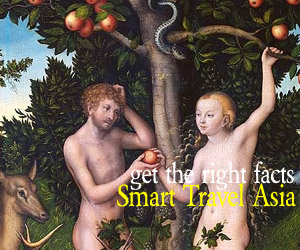|
DISCOVERIES Penang guide to cheeky street art and peeling muralsStreet murals featuring cycles and other props afford visitors much merriment and opportunities for 'in-the-frame' shots. The wall art changes fast though, writes photographer explorer David Sutton. Reprinted from The Mango Road diaries. by David Sutton 1 February 2024 SEE ALSO Goa resorts guide | India Spas | Kerala Resorts | Ladakh guide | Mumbai business hotels | Asian resort weddings guide | KL Hotels Guide | Bangkok shopping guide | Phuket Fun Guide | Langkawi Resorts Review | Child friendly hotels in Asia | Penang resorts review 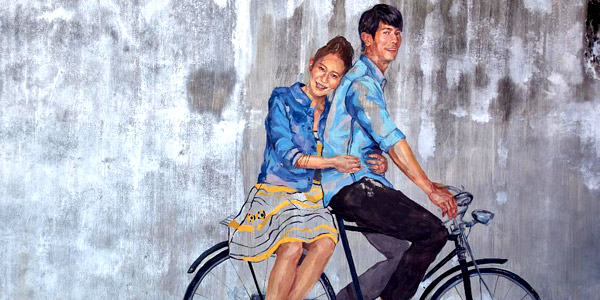
Penang's George Town is awash in murals and surprising sights for the eyes if you take the time to stroll about and review the wall art that has proliferated over the years / photo: David Sutton “Have you seen Bruce Lee?” Not yet, I said, can’t you find him? “No, it’s the only one we haven’t seen.” Give me your WhatsApp then, if I spot him I’ll send you directions, I laughed. I’m pretty sure though there were dozens the couple from Singapore hadn’t seen. One of the joys of exploring Penang’s street art is that new works pop up with no announcement while older works fade or are painted over as buildings are renovated. Penang, with its rich multicultural history and agreeable beaches, has always been a popular tourist destination. Its historic centre was awarded UNESCO World Heritage status in 2008. Its mix of Malay, Indian, Chinese and Middle Eastern cuisines make it a foodies paradise. But in recent years George Town’s urban art has become a tourist attraction in its own right. It took off in 2012 when the George Town Festival commissioned a project called Mirrors, a series of murals by Lithuanian artist Ernest Zacharevic depicting local culture and people. Since then the street art scene has flourished. George Town has become a living gallery with even businesses joining the fun by getting their own art painted onto their outside walls. It can be difficult, at times, to tell the difference between art and advertising. Complementing the murals is a series of wrought iron sculptured cartoons visualised by local artists; Julian “Lefty” Kam, Baba Chuah, Reggie Lee and Tang Mun Kian giving historical snapshots at various locations around the city. Most of the famous works are congregated in a fairly small area centered on Lebuh Armenian. But for true lovers of street art, there are plenty more beyond. After consulting the internet and several different versions of tourist maps I charted out my own course. I was hoping to find some interesting architecture between the art. 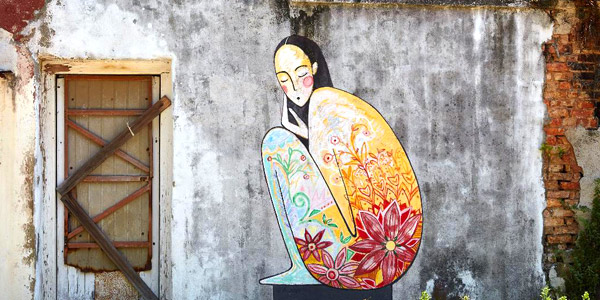
Seated woman adorns a wall awaiting a passing shutterbug / photo: David Sutton I learned pretty quickly though, that unless you have eyes in the back of your head and x-ray vision, there will be plenty of things that you miss. What follows is a description of my own art walk route and a gallery of some of my favourites that I didn’t miss. I’m not going to give precise locations. That would spoil the fun of the hunt, they may not be there when you go anyway and there will probably be new ones that were not there when I went. Send us your Feedback / Letter to the Editor CHEW'S JETTY There are six jetties in total all over one hundred years old. They were built in 1882 after the construction of Weld Quay (now Pengkalan Weld). Initially, they were just landing stages where goods were loaded and unloaded from sampans. Over time they grew into little villages each one dominated by a single clan. There are two murals on Chew’s Jetty although the one painted by Ernest Zacharevic appeared to be covered. Possibly for touching up? The jetty itself is interesting to wander around but it can get pretty busy during the day thanks to its numerous eateries and souvenir shops. Best to go early. WELD TO ARMNIAN Turn right after leaving the jetty and then left into Lebuh Chulia (Chulia Street). Look out for the both Container Hotel on the left and the small side road opposite. Continue along Chulia and then left again into Lebuh Victoria and continue until it meets Lebuh Armenian where there is a right turn. The Ming Xiang Tai Pastry Shop on the corner has some traditionally painted sun blinds and an old pedal-powered sales cart outside. There is a lot to see in Armenian, particularly after you cross the intersection with Lebuh Pantai (sometimes still called Beach Street). Be sure to leave no alley or doorway unexplored. There are a lot of souvenir shops, coffee shops and cafés. Also worth a visit is the Museum of Batik Painting on this narrow stretch. 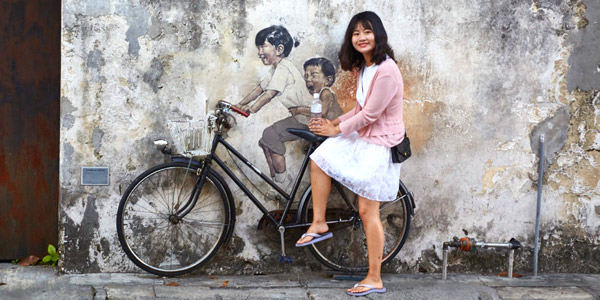
One of the many cycle murals that pop to surprise and delight visitors, affording opportunities to 'participate' in the art and step into the picture/ photo: David Sutton Before reaching the next road keep an eye open for the little alley on the right next to a shop renting bicycles. At the intersection itself, you’ll see the richly decorated Choo Chay Keong Temple and Yap Temple. The former was built in 1924 to house the Yap clansman deities. Right next door is the Asia Camera Museum. AROUND THE HOUSES Turn left in front of the temple into Lebuh Cannon. On the right is a row of beautifully restored shophouses several of which have been converted into restaurants. On the left is a row of shops selling clothes and jewellery with merchandise spilling out into the street. Facing the end of this short stretch is the Masjid Malayu Lebuh Aceh Mosque. The mosque itself was built in 1808 but the surrounding area is part of the original Muslim settlement dating back to the mid-nineteenth century. As the area developed it went on to become the centre of Islamic studies in Penang and was visited by traders from as far afield as India and Arabia. A right turn at the mosque into Lebuh Aceh. There are more shops on the right and a couple of curious Art Deco-style buildings dated 1940 on the left but there is no indication of what they might be or might have been. There are numerous Art Deco-style structures around Penang. Many of them are fairly simple in design squeezed into the ever-present five-foot way. Indeed I suspect a lot of them were not even built during the period but merely borrowed the form because the owners liked it. Nevertheless, they don’t look out of place amidst the more conventional house and shophouse styles. At the top of Lebuh Aceh there is a left turn into Lebuh Carnarvon and another into Lebuh Malayu. At the corner of Carnarvon and Malayu is a restaurant called Two Buns: Honest Burgers and Milkshakes which features some bizarre sculptures and a gargoyle clinging to the pillar of its five-foot way. Malayu itself boasts a mix of shophouse styles, some beautifully restored others atmospherically dilapidated. There is a ghost museum at number 57 with a row of dismembered hands and feet dangling over the front. Not my cup of tea but the children might enjoy it. Enter at your own risk. 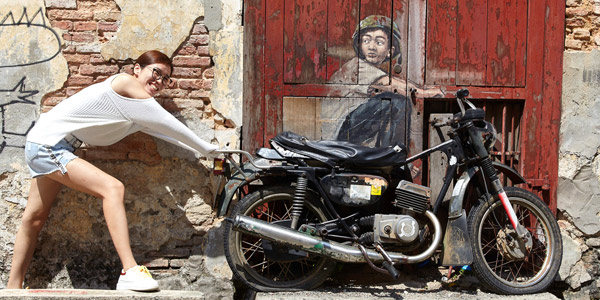
Hang on that's my bike! Tourist poses with boy on a motorbike preventing a quick getaway. Make time also for street food and old mansions that emerge at every turn. / photo: David Sutton About 200 metres down, on the corner of Lorong Toh Aka (Toh Aka Lane) is a stern grey Art Deco-style building, this one giving 1950 as its year of construction. The building is owned by the Lung Yen Clan Association but doesn’t appear to be used for anything at present. Much of the area around Lorong Toh Aka was owned by the Cheah clan and was known for its iron smiths. Indeed looking at the wrought iron fences and sturdy window bars one might be tempted to think it still is. Halfway along the lane turns abruptly right and continues until it meets Lebuh Pantai. I suspect the red door on the left that Oscar the Grouch inhabited will have been painted over by now but there are other works to see here. THE BEACH Lebuh Pantai is one of the oldest roads in Penang. It was laid out soon after the founding of Penang in 1786 and became the commercial and financial heart of George Town. Its former name, Beach Street, reflects the fact that it originally ran along the coast. Though Beach may have been a rather optimistic name as it was reportedly little more than a bank of mud. Reclamation was carried out from 1870-90 pushing the new city’s coastline some 200 metres to the east. The road is rather sleepy now but it is not difficult to imagine how it would have been when it was a bustling entrepôt. About 500 metres along, after crossing both Lebuh Aceh and Armenian you will pass the beautifully restored Seh Tek Tong Cheah Kongsi. This is the ancestral hall and temple of the Cheah Clan. It was built in 1873 and is now a museum. Beyond this, there are two more Art Deco-styled shophouses, one dated 1925, the other 1960. The latter presumably styled so to match its neighbour. A couple of doors further along is Lebuh Ah Quee. There is a whole street of blank walls here just calling out for some colour. Some have already been painted on. About 50 metres along there is a winding back alley leading through to Lorong Pitt. Keep your eyes peeled, some things are difficult to spot. At the end of the alley, a right turn into Lorong Pitt leads to the Nagore Durgha Sheriff on Lebuh Chulia. This is the oldest Indian Muslim shrine in Penang and is dedicated to Syed Shahul Hamid, a thirteenth-century Muslim saint from Nagore, India. It was built in 1803 by Muslims of southern Indian origin known as Chuliers. They were primarily merchants and moneylenders who began to populate the area at the end of the eighteenth century. It was from them that Lebuh Chulia took its name. 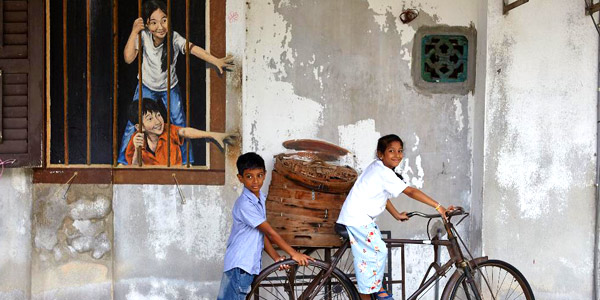
George Town’s urban art has become a tourist attraction in its own right. It took off in 2012 when the George Town Festival commissioned a project called Mirrors, a series of murals by Lithuanian artist Ernest Zacharevic depicting local culture and people / photo: David Sutton TWO CHULIAS, STEWART AND MUNTRI Turn left into Lebuh Chulia. On the left is the Han Jiang Ancestral Temple, built in 1890 by the Teochew community. After about 250 metres turn right into Lorong Chulia and follow the lane to the end where it meets Lorong Stewart. There are a lot of budget hotels, hostels and cafés in this area but the row of immaculately restored houses to the right of the Tipsy Tiger are in fact the luxurious Kerbaya Dining Room. Across the way is Café 55 and the Gehrig Art Gallery. Turning left into Lorong Stewart passes a lovely old mansion on the right and the narrowest five-foot way in all of Penang on the left. After it crosses Love Lane Lorong Stewart becomes Lebuh Muntri. There are a lot of very nicely preserved houses along here. Look out for the small Penang Ta Kam Hong temple. The temple was built in 1903 for the Goldsmiths Guild but is not open to the public. Directly opposite is the old Lam Wah Ee Hospital Building. Built in 1955 it boasts Art Deco-style symmetry but absolutely nothing in the way of ornamentation. The hospital has since moved to modern premises. The Hainan temple, a little further along was built in 1895 by immigrants from Hainan Island in China. The temple is dedicated to the Taoist Deity Mazu, the protector of seafarers. Near the end, Muntri intersects with Lebuh Leith. The Gala House Restaurant and bar is on the right, a converted old corner shophouse with a small balcony on the front, and beige walls with a reddish brown trim. Across from that is another old corner shophouse that was in the process of being renovated. On the other side of Leith is the World Optical Company building which houses the Modern Hotel on its upper floor. I believe the optical company has since vacated its premises but I don’t know what the ground floor is used for now. Across the street from here is pristine The Southern Hotel, beautifully restored with an immaculate five-foot way. At the end of Muntri is Jalan Penang. Turn right here and walk along until you see the Peking Hotel on your left. Opposite the hotel is a car park where, on the wall to the right, is a huge mural of a trishaw and driver. If you have made it this far you are probably in need of a fortifying plate of char kwei teow. There is an excellent little food court back along Jalan Penang at the corner of Kampung Malabar. There is plenty more art on the walls and there is still the arts community at the Hin Bus Depot. But maybe that is for another story.
NOTE: Telephone and fax numbers, e-mails, website addresses, rates and other details may change or get dated. Please check with your dealer/agent/service-provider or directly with the parties concerned. SmartTravel Asia accepts no responsibility for any inadvertent inaccuracies in this article. Links to websites are provided for the viewer's convenience. SmartTravel Asia accepts no responsibility for content on linked websites or any viruses or malicious programs that may reside therein. Linked website content is neither vetted nor endorsed by SmartTravelAsia. Please read our Terms & Conditions. |



